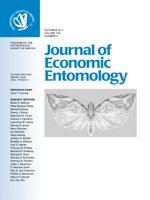Russian wheat aphid, Diuraphis noxia (Kurdjumov) (Hemiptera: Aphididae) was recorded for the first time in South Africa in 1978. In 2005, a second biotype, RWASA2, emerged, and here we report on the emergence of yet another biotype, found for the first time in 2009. The discovery of new Russian wheat aphid biotypes is a significant challenge to the wheat, Triticum aestivum L., industry in South Africa. Russian wheat aphid resistance in wheat, that offered wheat producers a long-term solution to Russian wheat aphid control, may no longer be effective in areas where the new biotypes occur. It is therefore critical to determine the diversity and extent of distribution of biotypes in South Africa to successfully deploy Russian wheat aphid resistance in wheat. Screening of 96 Russian wheat aphid clones resulted in identification of three Russian wheat aphid biotypes. Infestations of RWASA1 caused susceptible damage symptoms only in wheat entries containing the Dn3 gene. Infestations of RWASA2 caused susceptible damage symptoms in wheat entries containing Dn1, Dn2, Dn3, and Dn9 resistant genes. Based on the damage-rating scores for the seven resistance sources, a new biotype, which caused damage rating scores different from those for RWASA1 and RWASA2, was evident among the Russian wheat aphid populations tested. This new biotype is virulent to the same resistance sources as RWASA2 (Dn1, Dn2, Dn3, and Dn9), but it also has added virulence to Dn4, whereas RWASA2 is avirulent to this resistance source.
BioOne.org will be down briefly for maintenance on 17 December 2024 between 18:00-22:00 Pacific Time US. We apologize for any inconvenience.
How to translate text using browser tools
1 October 2011
Distribution and Diversity of Russian Wheat Aphid (Hemiptera: Aphididae) Biotypes in South Africa and Lesotho
Astrid Jankielsohn
ACCESS THE FULL ARTICLE
It is not available for individual sale.
This article is only available to subscribers.
It is not available for individual sale.
It is not available for individual sale.

Journal of Economic Entomology
Vol. 104 • No. 5
October 2011
Vol. 104 • No. 5
October 2011
biotype
Diuraphis noxia
host plant resistance
Russian wheat aphid




